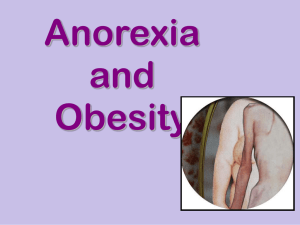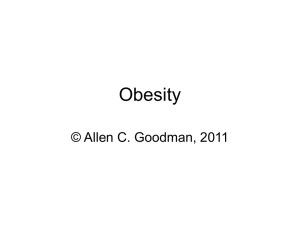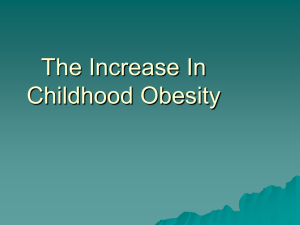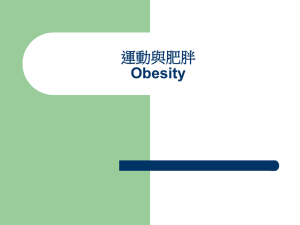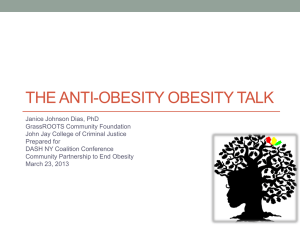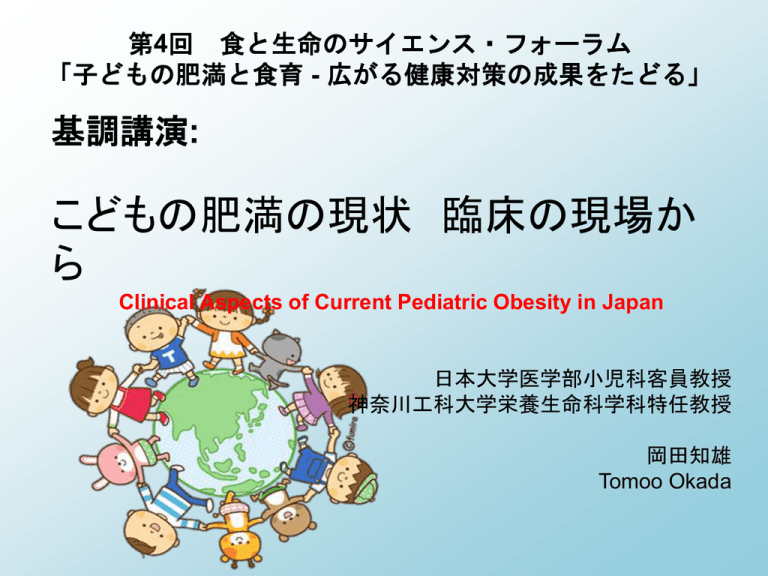
第4回 食と生命のサイエンス・フォーラム
「子どもの肥満と食育 - 広がる健康対策の成果をたどる」
基調講演:
こどもの肥満の現状 臨床の現場か
ら
Clinical Aspects of Current Pediatric Obesity in Japan
日本大学医学部小児科客員教授
神奈川工科大学栄養生命科学科特任教授
岡田知雄
Tomoo Okada
Contents
• Child Obesity in Japan and Western countries
• Relationship between Child obesity and the
Environments
• Characteristics of Child obesity with Metabolic
syndrome
• Abdominal Circumference and Fatty Acid Metabolism
• Low birth weight and catch-up Fat in DOHaD
• Effect of Cognitive Behavioral Therapy
• Very Low Calorie Diets for Morbid Obese Children
30
25
USA
England
20
France
15
10
5
0
1960
1970
1980
1990
2000
Source: IOTF 2004
Prevalence %
Overweight children 7-11:
Trends in the last three decades
2009-2010年 Child obesity USA
Prevalence of Obesity in Junior High School Children
足立区中学生(37校)におけるやせ・肥満の出現率
2012
6
5
4
男子(7,305人)
Boys (n=7,305)
3
Girls (n=6,751)
女子(6,751人)
%2
Total (n=14,056)
合計(14,056人)
1
0
やせ
Underweight
軽度肥満
mild
中等度肥満
moderate
高度肥満
severe
Obesity
n
Underweight girls
351
Severe obesity (total) 285
Obesity (total)
1,514
prevalence
3.11%
1.55%
10.77%
Outdoor playing and habitual exercise are
important factors for prevention of Child
Obesity(肥満、脂肪肝)
4th and 5th Grade boys who moved from Gunma Pref. to
Tokyo, they become obesity with fatty liver within only
one year.
呑龍様
大光院
遊び:
外遊
び、木
登り
駆けっ
こ、隠
れんぼ
コンビニ、テレビゲー
ム、遊び場無し、外遊び
なし。校庭開放?児童
館おかし?
Outdoor playing space in Yokohama
わが国のこども達の遊び環境の変化
仙田 満
Outdoor playing space for children drastically decreased in 1960’s and 70’s.
Screen Time and Obesity in Children
子ども達がテレビ等視聴,ファミコン等で遊んでいる 実態と肥満との関係調査成績
日本小児科学会こどもの生活環境改善委員会(大国真彦ら). 日本小児科学会雑誌1997;99:
TV watching
4:00-8:00
8:00-12:00
12:00-16:00
16:00-21:00
1.
Mean screen time :
164 min/day
2.
16:00 – 21:00 :
87% of children watch TV.
3. Video watching time is longer in infants.
4. Video game time is longer in boys.
5. Screening time is positively correlated with percent
21:00-24:00
overweight.
Percent overweight (%)
Screen time (hr.)
0:00-4:00
Screen time (min.)
Prevalence of obesity (%)
Obese Children in Fukushima
Fukushima
Fukushima
National Average
National Average
’09
’10
‘12
福島民報 2012年12月25日
The prevalence of obese children in
Fukushima was the highest in all of
Japan's 47 prefectures in 2012.
Changes of intake seafood
平成23年度水産白書
肉の摂取量にはあまり変化がないが、
Decreasing intake of seafood appears every year
Metabolic Syndrome in Children
Diagnostic criteria of Metabolic Syndrome in Japan
1) Abdominal
circumference
2) Serum lipids
3) Blood pressure
4) Fasting glucose
Adults
Children
≧ 85 cm (Male)
≧ 90 cm(Female)
≧ 80 cm (Boys and
Girls)
TG≧ 150 mg/dl
TG≧ 120 mg/dl
And/or
And/or
HDLC < 40 mg/dl
HDLC < 40 mg/dl
SBP ≧ 130 mmHg
SBP ≧ 125 mmHg
And/or
And/or
DBP ≧ 85 mmHg
DBP≧ 70 mmHg
≧ 110 mg/dl
≧ 100 mg/dl
*: waist/height ratio ≧ 0.5
Metabolic Syndrome : 1) and、2 components of 2), 3), 4)
Subclinical Atherosclerosis in Obese Children
原 光彦 他:肥満研究 Vol.12(1), 2006.
Subjects:
Abdominal ultrasonography
30 obese children
Subcutaneous fatLinea alba
Mean age; 10.7 years
Mean percentage of overweight; 52.6%
Preperitoneal Fat
P < 0.001
Liver
Pritonea
×
8
NonObese
(n=41)
Obese
(n=30)
y = 0.132 x + 2.278
( r = 0.480, p < 0.0001)
7
6
β
n.s.
5
4
3
2
1
0
2
4
6
8 10 12 14 16 18 20 22
Preperitoneal Fat Thickness (mm)
Desaturase Activities, HOMA-R and CRP Levels in
Children with or without Abdominal Obesity.
Saito E, Okada T, et al. Prostaglandins Leukot Essent Fatty Acids. 2013; 88: 307-11.
Children with abdominal obesity
Children without abdominal obesity
*
0.15
D5D Activity
*
0.20
0.10
5
*
4
*
3
2
0.05
1
0
0
Boys
Boys
Girls
Girls
0.20
7
*
*
6
5
CRP
HOMA-R
D6D Activity
0.25
6
*
4
0.15
0.10
3
0.05
2
1
0
0
Boys
Girls
Boys
Girls
Monounsaturated Fatty Acids
Carbohydrates
SCD; Stearoyl-CoA Desaturase
Very Low-Density Lipoproteins
Docosahexaenoic acid content in plasma phospholipids
and desaturase indices in obese children.
Saito E, Okada T, et al.. J Atheroscler Thromb. 2011;18:345-50.
32 obese children (27 male, 5 female)
12.0±2.6 years (mean ± SD)
Relative body weight > 120%
The relationship between DHA content and desaturase indices and variables
Correlation Coefficient
p value
Body mass Index
Waist/Height ratio
Total Cholesterol (mg/dl)
HDL-Cholsterol (mg/dl)
Triglyceride (mg/dl)
VLDL-Triglyceride (mg/dl)
LDL-Cholesterol (mg/dl)
Fasting Insulin
Fasting Glucose
HOMA-R
-0.337
-0.116
-0.058
0.091
-0.304
-0.558
-0.142
-0.101
0.239
-0.015
0.0592
0.5276
0.7559
0.6802
0.0967
0.0057
0.5170
0.5946
0.2034
0.9400
SCD16
SCD18
D6D
D5D
-0.373
-0.580
-0.110
0.236
0.0357
0.0005
0.5474
0.1931
Cod Liver Oil Supplementation for Obese Children
Fujita Y, Okada T et al. Obes Res & Clin Prac 2014, Articles in Press.
Study design
Subjects:
10 obese children
( 9 males,1female )
Age:
11〜16 years
(12.9±1.5)
Relative weight: 137.0〜193.5% (52.0±17.3)
Cod liver oil supplement:
4 g/day for 12 weeks
Results
.015
.01
r = 0.817
p = 0.0039
.005
Change in SCD index
Change in DHA (%W/W)
3.5
3
2.5
2
1.5
1
.5
0
-.5
-1
-1.5
-2
0
-.005
-.01
-.015
-.02
-.025
r = 0.662
p = 0.0370
-.03
3.5 4 4.5 5 5.5 6 6.5 7 7.5 8 8.5 9
DHA at baseline (%W/W)
3.5 4 4.5 5 5.5 6 6.5 7 7.5 8 8.5 9
DHA at baseline (%W/W)
Effects of Fish Oil Supplementation on Markers of the
Metabolic Syndrome
Pedersen MH et al. J Pediatr 2010;157:395-400
Study design
Subjects: 78 boys
Age:
13〜15 years
Body fat %: 30.0 ± 9.0% (BMI = 22~25)
Control study
Fish oil (1.5 g n-3PUFA /day) for 16 weeks
Vegetable oil
for 16 weeks
Conclusion
VO group
SBP
DBP
HDLC
Non-HDLC
TG
Insulin sensitivity
FO group
Mechanisms for the anti-obesity effect of DHA, n-3 PUFAs
DHA induces beta-oxidation in adipocytes and the small intestine.
Li JJ, Huang CJ, Xie D. Mol Nutr Food Res 2008;52:631-45
van Schothorst EM, et al.BMC Genomics. 2009;10:110.
Flachs P, et al. Diabetologia. 2005;48:2365-75.
DHA inhibits adipocyte differentiation and induces apoptosis in 3T3L1 preadipocytes.
Kim HK, et al. J Nutr 2006;136:2965-9.
n-3 PUFAs markedly stimulate thermogenic activity in brawn
adipose tissue.
Oudart H, et al. Int J Obes Relat Metab Disord. 1997;21:955-62.
Another possible mechanism, i.e.
DHA suppression of SCD activity.
Developmental Origins of Health and Disease:
DOHaD
David Barker proposed a hypothesis that undernutrition in utero
permanently changes the body‘s structure, function and metabolism in
ways that lead to atherosclerosis and insulin resistance in later life.
Intrauterine undernutrition
Obesity, Hypertension, Dyslipidemia,
Insulin resistance
Atherosclerotic Diseases
Type 2 diabetes and hypertension have a common origin in sub-optimal development in utero, and that
syndrome X should perhaps be re-named "the small-baby syndrome".
Barker DJ, et al. Diabetologia. 1993;36:62-7.
Prevalence of Syndrome X
20%
10%
<2.50
−2.95
ー3.41
−3.86
−4.31
Birth Weight(kg)
4.31<
Subcutaneous Fat Accumulation in Light-for-dates
(LFD) Infants with Catch-up in Body Weight
Postconception period (day)
Body Weight (g)
Skinfold Thickness (mm)
In LFD infants with catch-up growth in body weight, their
subcutaneous fat is over-accumulated.
Postconception period (day)
Postnatal Catch-up Fat after Late Preterm Birth
Gianni M, et al. Pediatr Res. 2007;72:637-40.
Subjects and Methods
49 late preterm infants (birth weight 2,496 ± 330 g, gestational age 35.2 ± 0.7 weeks)
Body composition (day5, term-equivalent age, corrected age1mo., 3mo. (PEA POD)
Results
体脂肪増加率
(%) fat
Percent
increase in body
Body Fat (%)
Late preterm
34 – 36 wk
200%
Full Term
5.7 (3.9)
Term
16.1 (4.6)
8.9 (2.9)
1 mo
22.6 (4.2)
17.4 (4.0)
3 mo
26.7 (4.3)
27.1 (3.9)
100%
Mean (SD)
At birth, percentage of body fat in LPIs is lower
than that in FTIs.
At term-equivalent age, and corrected age 1 month,
LPIs had greater percentage of body fat than FTIs.
0%
35wk – term Birth/term – 1 mo
1 - 3 mo
Rapid fat accumulation is demonstrated in LPIs during the first month of age (2.8fold)
The Mechanism of Rapid Subcutaneous Fat Accumulation
During First Month of Life
Yoshikawa K, Okada T, et al. Eur J Clin Nutr. 2010;64:447-53.
Correlation coefficients with lipoprotein lipase
At birth
Skinfold thickness
VLDL-TG
At 1 month
Skinfold thickness
VLDL-TG
180
p
0.0001
<0.0001
0.614
-0.429
<0.0001
0.0052
r=0.009, p=0.9508
160
140
120
100
80
60
40
20
0
-3.0
r=0.633, p<0.0001
-2.5 -2.0
-1.5
-1.0 -0.5
0
450
r=0.639, p<0.0001
350
250
150
50
-50
0.5
Birth Weight Z-score
Cord blood
Rapid subcutaneous fat
accumulation may be
induced by LPL activation
in LFD infants.
550
Percent increase in
LPL mass (%)
LPL mass (ng/ml)
r
0.573
-0.692
1.0
-3.0 -2.5 -2.0 -1.5 -1.0
-0.5
Birth Weight Z-score
At 1 month
0
0.5 1.0
Adiposity Rebound Period
• Around 5yrs it begins
generally
• Less than 5yrs if it start
become later OB
• Adiposity rebound may
be critical period to
developing OB
Dietz W. Critical periods in childhood for the development of obesity
Am.J.Clin.Nutr (1994)59;955-959
Cognitive Behavioral Therapy Including Self-monitoring
Daily-life Checking Sheet
チェックした日
早起きをする(
/
/
/
/
/
/
/
総
計
/
/
/
/
/
/
/
総
計
)
:
朝ごはんを食べる
給食の時おかわりしな
い
夜食はたべない
ジュースを飲まない
おやつの量を守る
体を動かす
テレビやゲームは2時間
以内
家の手伝いをする
早く寝る(
:
)
合計
都立広尾病院小児生活習慣病外来
Two Cases of Severe Pediatric Obesity
Case 1.
S.S. 2y. 6m. Boy
Case 2.
N.K. 15y. 2m. Boy
+2SD
Height (cm)
170
+2SD
Height (cm)
+1SD
Mean
-1SD
+1SD
-2SD
Mean
150
-1SD
-2SD
100
90
+2SD
120
80
+1SD
Mean
-1SD
Weight (kg)
+2SD
+1SD
Mean
-1SD
-2SD
30
-2SD
20
Weight (kg)
60
Cognitive Behavioral Therapy for Obese Children
内田則彦、朝山光太郎、他:日児誌
104(4), 420-425, 2000
のデータから作図
Subjects and Methods
50 obese children (mean age 9 y.o., mean relative weight 147.6%)
After the cognitive behavioral therapy using the daily-life checking sheet for 200 days,
improved: Δ relative weight < -30%, not improved; Δ relative weight > -30%
Improved
Boys
Girls
Total
Not improved
Very Low Calorie Diets for Morbid Obese Children
Subjects and Methods
n
15
Age(year)
15.9±4.9
Sex
10M/5F
Height (cm)
162.5±10.2
Weight (kg)
92.8±22.0
Percent of Overweight (%)
74.3±31.2
Results
163.6±9.7
86.8±16.7
60.9±28.0
Mean±SD
(Breakfast) for 2 months
165 kcal/meal
熱量
セレン 100
マンガン
80
亜鉛
60
鉄
40
20
リン
たんぱく質
脂質
ビタミンA
ビタミンB1
ビタミンB2
0
マグネシウム
ビタミンB6
カルシウム
ビタミンB12
カリウム
ビタミンC
葉酸
パントテン酸
ビタミンD
ビタミンE
ナイアシン
Percent of Overweight
Summary
Lifestyle interventions are effective for mild obese
children, especially when initiated at a young age.
However, in cases of severe morbid obesity, it is
difficult to treat successfully.
Therefore, efforts should be focused on the
prevention of obesity from early childhood.



